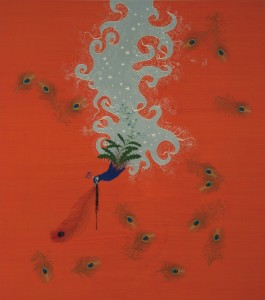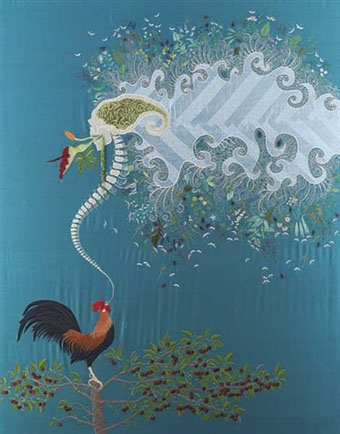
End of Presumption by Angelo Filomeno
(Credit: curatedobject.us)
Artist Angelo Filomeno learned about the harsh reality of death earlier than most. When he was just a child, he lost both of his parents quite suddenly. Beginning life as an orphan formed the backbone of Filomeno’s work in the modern art world. Most of his works feature skeleton motifs, often depicting two skeleton lovers intertwined for eternity. While these works are serious in nature, they have a whimsical beauty to them that is the hallmark of classic memento mori. Using unexpected materials, Filomeno puts a modern spin on this centuries-old art form.
Angelo Filomeno was born in Ostuni, Italy, spending most of his early years working as an apprentice for a tailor. He started sewing when he was 7, and he still uses these skills in his modern artworks. As a young man, he attended a fine arts school in Lecce, Italy, eventually receiving a painting degree. Rather than becoming a full-time artist, he used his education and background in sewing to work at Milan’s finest fashion houses after graduation. In 1992, he decided to move to New York to pursue his art full time, and has since become a celebrated artist.
What makes Filomeno’s art instantly recognizable is his use of embroidery and mixed media to convey his ideas. It’s incredible to see how many materials Filomeno meticulously manipulates to create his pieces.
In “Venom,” for example, a rooster appears to be crowing, but the sound is represented by a spine and a surreal depiction of a skull — an almost whimsical representation of death that is typical of Filomeno’s work. “Venom” also showcases Filomeno’s fashion background, featuring gorgeous silks and intricate crystal beading. But instead of molding these into a stunning gown, he instead uses them to comment on the fragility of life.

“Venom” by Filomeno
(Credit: John Coulth Art)
Although Filomeno depicts death in much of his work, he does so in a way that entirely avoids the macabre. This is not an easy task, especially for an artist who takes such a literal approach to the subject. It’s far too easy to create terrifying imagery in relation to death; it’s much more difficult to find a nuanced way of expressing mortality. Filomeno is a true artist, taking our greatest fears about death and expressing our complicated relationship with them through his work.

 Death, Venom and Angelo Filomeno
Death, Venom and Angelo Filomeno


 The Other Death in the Family
The Other Death in the Family

 The Healing Sound of Singing Bowls
The Healing Sound of Singing Bowls














